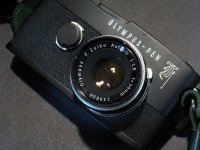squirrel$$$bandit
Veteran
Well. It seems that I am stumbling backwards into the world of the Olympus Pen--I recently started using a micro 4/3 camera, and along with it bought a Pen F adapter. Since then I've found, each for $100, a 40/1.4 (love it so far) and 100/3.5 (on its way).
It's beginning to feel inevitable that I should end up with an F body. So...what to look for? Which bodies are most reliable, most useful, etc? Is it worth getting a metered one, or is the meter more trouble than it's worth? I know Robert J. does some work on these, including replacing the mirror with a more efficient one--is this worth getting done?
It's beginning to feel inevitable that I should end up with an F body. So...what to look for? Which bodies are most reliable, most useful, etc? Is it worth getting a metered one, or is the meter more trouble than it's worth? I know Robert J. does some work on these, including replacing the mirror with a more efficient one--is this worth getting done?



